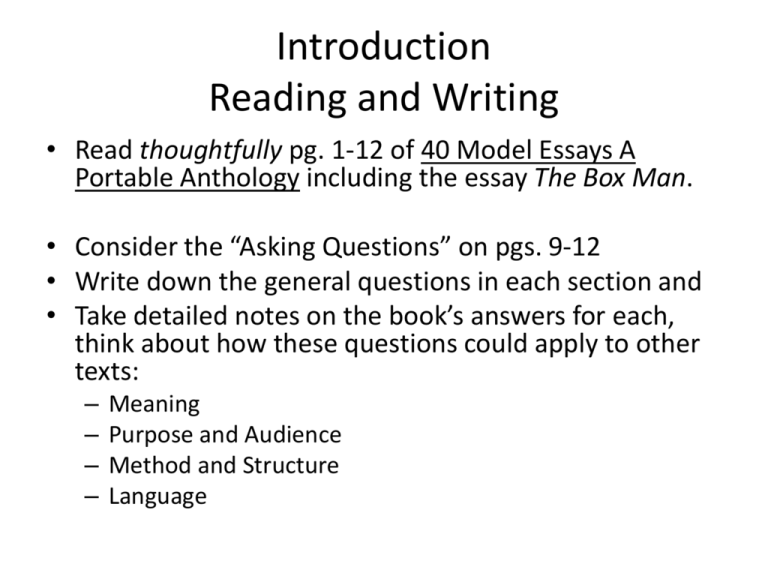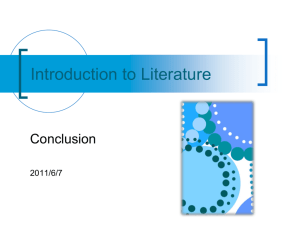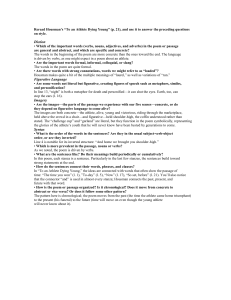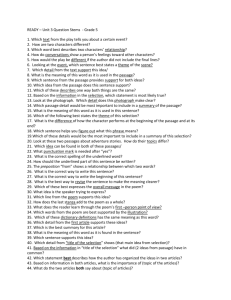Chapter 2 Close Reading: Analyzing Poetry and Passages of Fiction
advertisement

Introduction Reading and Writing • Read thoughtfully pg. 1-12 of 40 Model Essays A Portable Anthology including the essay The Box Man. • Consider the “Asking Questions” on pgs. 9-12 • Write down the general questions in each section and • Take detailed notes on the book’s answers for each, think about how these questions could apply to other texts: – – – – Meaning Purpose and Audience Method and Structure Language The Box Man by Barbara Lazear Ascher Present & Explain • Create a presentation that thoroughly explains an area of literary analysis in “The Box Man.” – Use the passages from 40 Model Essays as a guide to your explanation to the class. – Create 6 questions, one from each of the Bloom’s levels. – Use your analysis study guides to build your questions. • Format: – – – – Ppt Skit Posters Interactive quiz/game show Meaning • What is the main idea of the essay—the chief point the writer makes about the subject, to which all other ideas and details relate? What are the subordinate ideas that contribute to the main idea? 1. This essay implies to the reader that loneliness isn’t always a vile thing. The author compares somebody who has absolutely nothing in life but enjoys the solitude, to people who roam through life alone, seeking for company—but never find it. The author compares the chosen lifestyle of the box man, to the undesired for loneliness of the victims. The author explains that although one may be poor and alone, it does not mean that one is unhappy. For example, in paragraph 12 it is explained that the mayor has offered him help, but the box man pushes it away. In paragraph 18 it is described how the box man enjoys his dark life. It is portrayed that life is a solo journey and that one may be much more miserable by going through life accompanied than by being a collector of boxes. 2. A subordinate idea that contributes to the main idea is the way the author brought up memories from her own past, The Boxcar Children. These children were, like the Box Man, approaching their loneliness in a positive manner, which is something the author seemed to agree with. The other character, which suffered from a different type of loneliness, was a woman in a coffee shop, she dwelled through her loneliness. She had no peers in her life, and spent most of her time dragging on a coffee at the coffee shop, just to be surrounded by people. Purpose and Audience Why did the author write the essay? What did the author hope readers would gain from it? What did the author assume about the knowledge and interests of readers, and how are these assumptions reflected in the essay? 1. Barbara Lazear Ascher wrote this essay to help audiences see the difference between chosen and unchosen loneliness. With a numerous amount of examples she shows the reader the difference between someone who willingly chooses to live life alone, and people who find themselves lonely and dwell about it. 2. The author hoped that readers would understand the differences, and learn that life is not all about being surrounded by peers. The author hoped that by reading this essay, people realized that one enters life alone and leaves life alone.(last paragraph) Method and Structure • What method or methods does the author use to develop the main idea, and how do the methods serve the author’s purpose? How does the organization serve the author’s purpose? Language • How are the author’s main idea and purpose revealed at the level of sentences and words? How does the author use language to convey his or her attitudes toward the subject and to make meaning clear and vivid? Chapter 2 Close Reading: Analyzing Poetry and Passages of Fiction Assignment: • Read thoughtfully pg. 19-24 of Lit. & Comp. beginning with “What is Close Reading?” • Consider the questions on pgs. 23-24 writing complete sentence answers each: – Diction – Figurative Language – Imagery – Syntax Suggestions: • Go beyond just recognizing the elements of style to analyze their effects…and write about them. • Understand the way language adds another level of meaning to a work (identifying literary elements is NOT enough). Grow Your Cannon! • • • • • Read Reread Observe Ask questions Try to answer them Connect Language to Meaning • Look for: – – – – – Patterns Motifs Repetitions References to other works Connections to your own life and time • A word of advice: – The sample analyses are not the end-all-be-all. You are bound to come up with your own different and interesting interpretations, so don’t limit yourself by what the book (or another source) may say. And don’t be discouraged if you seem to be facing a blank wall; sometimes you just get stuck. In that case, move on. My Antonia by Willa Cather What part do the snakes play in this passage about happiness? • Snakes should set off alarm bells—they can’t help but make us think of evil and the serpent that tempted Eve in the Garden of Eden. The narrator has set himself up in a place where he is protected from snakes, or will at least be alerted if one should come along. Cather may be acknowledging the idea that life always has snakes, but we can at least be aware of them before they’re upon us. What might it mean that the passage is set in a garden? • Taking off from the snakes in the first sentence, we can’t help but think of the Garden of Eden. The young narrator is discovering an idyllic world; he is innocent, protected, in touch with nature. How big is that pumpkin? How big are the grasshoppers, really? • The pumpkin and the grasshoppers are, of course, elements of setting, but they also help characterize the young narrator, who has just moved out west from Virginia. Things really are more immense in his new home; the sense of wide-open space pervades most of the novel, as do the mythic proportions of the natural world. On the other hand, the narrator is quite young; thus, a pumpkin he can lean against would be big but not huge. His sense of the grasshoppers as twice as large as any he’s even seen is, in part, the hyperbole of a young boy. What makes the objects in the passage so vivid? • The images in this passage are quite concrete, depending on verbs and nouns to appeal to nearly every sense. We hear the wind; we feel the warm earth; we see the acrobatic grasshoppers and the scurrying gophers. Why does the narrator connect happiness and death? • It seems unlikely that a young person would have such profound thoughts on death. We should probably consider this an intrusion of the perspective of the adult narrator looking back on his youth. It might even be an intrusion from the author herself, as the last two sentences of this passage are on Cather’s tombstone. On the other hand, it does feel pretty organic. It may be the closest Cather can come to describing the ecstasy of happiness and her commitment in this novel to the importance of a connection to the natural world. How does the narrator fit—literally and figuratively—into the landscape? • He is, as we mentioned, quite young (maybe 9 or 10). He’s been recently orphaned and has been sent far from home. But there is no sense of loss or grief in this passage. He is literally and figuratively protected in this garden. He’s sitting on the ground, connected in both a concrete and an abstract way to the earth, and every one of his senses is stimulated by the plant and animal life around him. How does the passage change from beginning to end? • It becomes, of course, more abstract. The vivid depiction of the natural world, in language clear and concrete, leads to the narrator’s meditation on happiness: “to be dissolved into something complete and great.” The joy of the physicality of the world he describes is so palpable that even the introduction of the ide of death does nothing to tamp down that sense of ecstasy. To an Athlete Dying Young by A.E. Housman Create your own first-impression questions. • Who is the speaker, and who is the speaker address? Who is “you”? • What does “chaired” mean? Is it like “cheered”? • Why is the word order shifted (“home we brought you”)? • Why does a laurel wither quicker than a rose? • Why does this poem rhyme? • Why do all of the lines have almost the same number of syllables? • What does the speaker mean by “see the record cut”? Analyze and Explain the Effect • Here are some starting points…mine a questions and develop a response. Diction Which of the important words (verbs, nouns, adjectives, and adverbs) in the poem or passage are general and abstract, and which are specific and concrete? • The words in the beginning of the poem are more concrete than the ones toward the end. The language is driven by verbs, as one might expect in a poem about an athlete. Are the important words formal, informal, colloquial, or slang? • The words in the poem are quite formal. Are there words with strong connotations, words we might refer to as “loaded”? • Housman makes quite a bit of the multiple meaning of “laurel,” as well as variations of “run.” Figurative Language Are some words not literal but figurative, creating figures of speech such as metaphors, similes, and personification? • In line 13, “night” is both a metaphor for death and personified—it can shut the eyes. Earth, too, can stop the ears (l. 16). Imagery Are the images—the parts of the passage we experience with our five senses—concrete, or do they depend on figurative language to come alive? • The images are both concrete—the athlete, alive, young and victorious, riding through the marketplace, held above the crowd in a chair—and figurative—held shoulder-high, the coffin understood rather than stated. The “challenge cup” and “garland” are literal, but they function in the poem symbolically, representing the glories of the athlete’s youth that he will never know have been bested by generations to come. Syntax What is the order of the words in the sentences? Are they in the usual subjectverb-object order, or are they inverted? • Line 4 is notable for its inverted structure: “And home we brought you shoulder-high.” Which is more prevalent in the passage, nouns or verbs? • As we noted, the poem is driven by verbs. What are the sentences like? Do their meanings build periodically or cumulatively? • In this poem, each stanza is a sentence. Particularly in the last few stanzas, the sentences build toward strong statements at the end. How do sentences connect their words, phrases and clauses? • In “To an Athlete Dying Young,” the ideas are connected with words that often show the passage of time: “The time you won” (l. 1), “To-day” (l. 5), “Now” (l. 17), “So set, before” (l. 21). You’ll also notice that the connector “and” is used in almost every stanza; Housman connects the past, present, and future with that word. How is the poem or passage organized? Is it chronological? Does it move from concrete to abstract or vice versa? Or does it follow some other pattern? • The pattern here is chronological; the poem moves rom the past (the time the athlete came home triumphant) to the present ( his funeral) to the future (time will move on even though the young athlete will never know about it).






